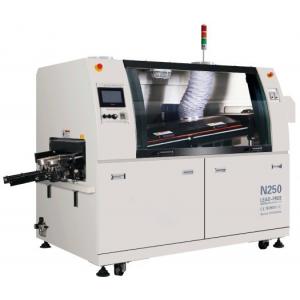Automatic SMT Wave Soldering Machine Hot Air Preheating Style
The wave soldering machine is an essential piece of equipment in the electronics manufacturing industry used for soldering through-hole components on printed circuit boards (PCBs). It offers a range of functionality and features that facilitate efficient and reliable soldering processes.
1. Automatic conveying power system and auto synchronous board feeding functions.
frequency conversing speed adjustment
Solder Pot peak uses frequency conversing speed adjustment which can independently control the wave height.
2. Fluxer system using transverse Japanese spray nozzle, driven by pneumatic cylinder and PLC control, accurate and reliable.
3. PLC is used to control the machine, to ensure the reliability and stability of the system.
4. Pre-heaters using Infrared heating element, heat radiated efficiently to the circuit board with fast ramp up and fully activating liquid flux.
5. Special alloy solder fingers, strengthened double v-groove.
6. Solder-motor adopts imported high frequency conversion motor with independent control, stable performance and long lifetime.
7. Pre-heater passage with modularized design, meet with environmental protection requirement, safety and convenient to cleanup.
8. Preheaters uses three independent temperature control so as to ensure the excellent heat preservation, temperature uniformity, temperature accuracy in ±2ºC.
9. Timer startup feature for solder pot, solder melted within 90 minutes.
10. Automatic finger cleaner ensure the cleanliness of solder fingers.
11. Intelligent monitoring and alarm system ensure the stable performance and operators’ safety.
Functionality:
1. Flux Application: The wave soldering machine applies flux to the PCBs before the soldering process. Flux is a chemical substance that removes oxidation from the metal surfaces, ensuring proper wetting and adhesion of the solder.
2. Preheating: The machine features preheating zones that elevate the temperature of the PCBs before they pass through the solder wave. Preheating ensures that the components and PCB are at optimal temperature for the soldering process, promoting better solder flow and reducing thermal stress.
3. Solder Wave: The machine creates a controlled wave of molten solder, typically a tin-lead alloy or lead-free solder, in a bath or nozzle. The solder wave is precisely controlled in terms of temperature, height, and width. When the PCB is passed over the solder wave, the through-hole components are immersed, and the solder forms reliable electrical connections.
4. Solder Nozzle/Immersion Depth Control: The machine allows for adjustable solder nozzle height or immersion depth. This feature ensures proper solder coverage on the through-hole leads and prevents excessive solder bridging or insufficient solder joints.
5. Conveyor System: The machine incorporates a conveyor system that transports the PCBs through the soldering process. The conveyor speed can be adjusted to achieve the desired soldering quality and throughput.
6. Flux and Solder Management: The machine includes mechanisms for flux and solder management. It may have systems for flux replenishment, solder level monitoring, and dross removal, ensuring consistent solder quality and reducing material waste.
Usage Range:
The wave soldering machine is used in various applications within the electronics manufacturing industry, including:
1. Through-Hole Component Assembly: The machine is primarily used for soldering through-hole components onto PCBs. It is suitable for components such as connectors, switches, transformers, and larger components that cannot be surface-mounted.
2. Mass Production: The wave soldering machine is well-suited for high-volume production environments. It offers efficient and continuous soldering processes, enabling the rapid assembly of large quantities of PCBs.
3. Mixed Technology PCBs: PCBs that contain a combination of surface mount components and through-hole components can be processed using the wave soldering machine. It allows for selective soldering, ensuring that only the through-hole components are exposed to the solder wave.
4. Repair and Rework: The machine is also used for repair and rework purposes. It can be employed to remove and replace through-hole components in cases where repairs or modifications are needed on assembled PCBs.
5. Automotive, Industrial, and Aerospace Electronics: The wave soldering machine finds applications in various industries, including automotive, industrial, and aerospace sectors. These industries often utilize through-hole components for their robustness and reliability, making the wave soldering machine an essential tool for their manufacturing processes.
The wave soldering machine plays a crucial role in the assembly of through-hole components on PCBs. It ensures reliable solder connections, high production throughput, and consistent solder quality, contributing to the overall quality and performance of electronic products.
| Model No. | Flason N350 |
| Number of pre-heaters | 3 |
| Pre-heater passage | 1600mm |
| Body size | 3300(L)*1400(W)*1560(H) |
| Outside dimension | 4100(L)*1400(W)*1560(H) |
| Weight | 1100KG |
| Total/steady consumption | 24KW/6-8KW |
| Air supply | 0.5MPa |
| Preheating style | Hot air |
| Preheater consumption | 220V 8KW |
| Control method | PC +PLC |
| Range of temp. set-point | Room temperature---300ºC |
| Preheating time | About 10-15mins for setting 150ºC |
| Solder application | Lead-free |
| Solder pot capacity | 320KG |
| Solder pot temperature | 300ºC |
| Solder pot consumption | 380V 12KW |
| Solder temp. control method | PID&SSR |
| Wave motor consumption | 1KW 220V |
| Solder melting | About 120mins for setting 250ºC |
| PCB width | 50-350mm |
| Conveyor speed | 300-2000mm/min |
| Conveyor direction | L to R (R to L optional) |
| Conveyor inclination | 4-7 º |
| Flux pressure/capacity | 3-5 bar/6.5L |


